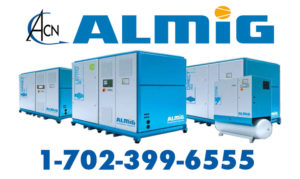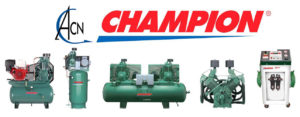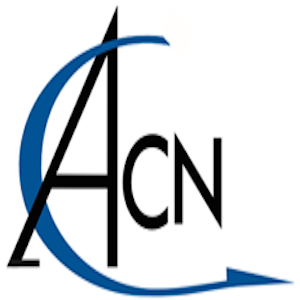ALMiG Screw Compressors

When the money you save by investing in a new compressor station practically offsets the contracting costs, it means more than just a short-term financial advantage. It means no further costs for maintenance, repair or spare parts throughout the duration of the contract. All of these costs are borne by the service partner, who also makes sure that your investment performs reliably for the duration of the contract. The benefits of this situation were discovered by Engeser GmbH in Schramberg- Waldmšssingen, Germany. The firm replaced seven old fixed-speed screw compressors in two compressed air stations with four new speedcontrolled screw compressors from Almig.
According to Stefan Fricke, managing director of the cable systems division Engeser Kabeltechnik, the costs of contracting out compressor maintenance are almost offset by the savings made. Engeser GmbH was originally founded in 1983 as a single company specialising in cable production and services. Today, the connector division Engeser GmbH Innovative Verbindungs technik supplies connection-ready cable systems. Engeser GmbH Kabeltechnik, now a world market leader with an annual capacity of 1.5 billion parts, manufactures and packages wire end sleeves and technical plastic parts in a fully automated process. A sister company in the Czech Republic, Engeser s.r.o., functions as an extended workbench for the Innovative Verbindungstechnik division. Today, the company employs 350 people and in 2010 generated sales of around € 40 million. “As a system supplier, we offer our customers complete assemblies using highly specialised techniques and production processes. Because our production site at Schramberg-Waldmšssingen is highly automated, we can manufacture cost-effectively right here in Germany. But this degree of automation wouldn‘t be possible without compressed air technology.
We need a reliable supply of compressed air 24 hours a day,” says managing director Stefan Fricke. In Schramberg-Waldmšssingen, production takes place in three facilities separated by a road, supplied with compressed air by two different stations. Station 1, which supplies plant 3 (Engeser Kabeltechnik), used to have three non-cont rol led screw compressors and station 2, which supplies plants 1 and 2 (Engeser Innovative Verbindungs technik), had four. Station 1 had an input power of 3 x 18.5 kW and station 2 had an input power of 1 x 37 kW, 1 x 30 kW and 2 x 15 kW. The compressors were controlled by pressure switches with delayed switch limits in a range of 8 – 10 bar. This produced greater compression, increasing both energy consumption and costs, as just 1 bar of extra compression demands 6% – 7% more energy. In addition, the switch-on pressure of the lowest pressure switch had to ensure sufficient network pressure. “All seven compressors were also relatively old. This resulted in incalculable costs for maintenance and spare parts. So we were looking for a new, more energy-efficient solution.
We were impressed by the technology and the benefits of the Almig VARIABLE speed-controlled screw compressors, so we started by replacing the three old screw compressors in station 1,” says Stefan Fricke. Precise investment planning with EBS analysis First of all, Almig performed an EBS analysis to establish how much compressed air was required. The analysis consists of three steps, Measure, Analyse and Simulate, and provides the data needed to choose the right components. n The first step (Measure) involves measuring the current level of utilisation of the compressors. Once the nominal output volumes of the individual systems are known it is possible to calculate the output volume they are producing and the output volume of the entire compressed air system. The operating pressure and power consumption of all compressors throughout the period are also measured during this step.
In the second step (Analyse) the measured data is analysed with evaluation software and the current energy costs and extrapolated energy costs per year are calculated. Additional data supplied by the EBS system in the form of tables and graphics permits an accurate analysis of the current compressed air situation. Almig can then explain to the customer in detail where there is potential for optimisation and draw up proposals for optimising energy use for compressed air generation. In the third step (Simulate), detailed data for the compressed air station is entered into the EBS system, which simulates different solution scenarios and shows how the energy costs would be changed by modifying individual systems or the complete compressed air concept. This makes it possible to identify the optimum approach. By comparing the energy-saving potential with the necessary investment costs (based on future energy costs) it is possible to calculate the cost-benefit ratio and the resulting return on investment. This ‘before and after’ scenario yields precise information about future energy costs before any investment decision is made. The likely heat output and resulting savings can also be estimated.
Speed control in duplicate On the basis of the simulation, Almig proposed installing two speedcontrolled, air-cooled VARIABLE 35 screw compressors (each delivering 1.06 – 5.70 m3/min at an operating overpressure of 8 bar). This proposal was implemented in May 2009 (NB: Almig supplies speed-controlled VARIABLE screw compressors for volume flows of up to 53.0 m3/min). The directly driven compressors, selected on the basis of the measurements taken, are large enough that one compressor can supply production site 1 at an optimum utilisation of around 70% while the other serves as a redundant system. Both compressors soft-start “at zero” and are operated by the Multi Control 3 controller in base load alternating mode, so that their runtimes are always the same and they can be serviced together. Each compressor has its own preparation line (including refrigeration dryer, submicrofilter and active carbon filter) to produce dry two speed-controlled, air-cooled screw compressors of type VariaBLe 35 are indicated by an operating message. Condensate is treated in accordance with regulations in an oil/water separator. Because the product ion of compressed air generates a lot of waste heat in the form of cooling air, any responsible operator will seek to make good use of this energy.
At a power consumption of 100%, 9% is emitted by the electric motor, 72% by the oil cooler and 13% by the aftercooler. The radiation loss is 2%. Just 4% remains in the compressed air. The usable heat therefore amounts to a maximum of 94%. Because the speed-controlled system is in continuous operation from Monday to Friday to supply the three-shift production facilities with compressed air, Engeser produces waste heat around the clock. In winter the heat from the compressors in station 1 (Engeser Kabeltechnik) is channelled through a system of pipes to heat the production area and also fed to the heating circuit through a heat exchanger in the compressor’s oil circuit. This allows the waste heat to be used as an air curtain for a roller shutter which previously required 30 kW of power. In station 2 (Engeser Innovative Verbindungstechnik), the waste heat is used to heat offices. Maintenance contract “The purchase of the two VARIABLE compressors brought with it a change of manufacturer. One important reason for the change was the much more cost-effective contracting model offered by Almig, which was much better than the proposal from our previous supplier in terms of key considerations.
Our contract for Almig runs for 10 years and allows for certain changes if necessary after five. It gives us the certainty of a guaranteed supply of compressed air and easily calculable costs. There are no additional costs for maintenance or spare parts during the contract period. We want to focus on our core competencies without having to worry about peripheral issues like sourcing compressed air. The maintenance contract gives us all the assurance we need in that respect. Throughout the 10-year contract period Almig guarantees to ensure a reliable compressed air supply system. And unlike before we don’t need to worry about a thing, because everything happens automatically. We can now get compressed air from the pipe just like we get electricity from the socket. All we pay for is the electricity costs,” Fricke says. To continually monitor the compressed air station and be able to intervene quickly if required, Almig also uses remote monitoring, which is available in two different models: With Plant Control T, the version chosen by Engeser, all compressor data can be viewed on the operator‘s own monitor and also transferred by modem to an external service centre or – as in this case – to Almig in Kšngen. Plant Control T allows all operating data to be used “online”, either at an external service station belonging to the operator or by a service partner. For example, an alert is issued 100 hours before a maintenance intervention is due. With the Plant Control V version, data from the compressor controller can be sent by modem or Profibus to a PC belonging to the customer, but not to an external partner (such as a service partner or Almig). Second station after 9 months “The first station was installed in May 2009. We soon realised that we had made an excellent choice with the two speed-controlled Almig VARIABLE screw compressors. The Almig concept fully satisfied our expectations. So in early 2010 we decided to modernise the second station, in the plant on the other side of the road, with Almig along exactly the same lines,” explains Fricke.
Four older, non-controlled screw compressors with a total output of 97 kW were also replaced by two VARIABLE systems, but this time with an input power of 55 kW each. The two previous compressed air stations were merged into a single system and the buildings connected by a compressed air line. and technically oil-free compressed air. This ensures redundancy for all compressed air generation and treatment components. If necessary the preparation lines can also be interchanged.
Any faults on the dryer the limited space required the control cabinets to be separated from the compressors and positioned on base frames that could be moved on castors each compressor has its own preparation line The high degree of automation would be impossible without compressed air However, when it came to installing station 2 there was a serious problem in relation to the available space. The complete station including two refrigeration dryers and the condensate system had to be set up in a space measuring just 2.8 x 6.8 m. Two existing light wells, serving as waste air vents, also had to be taken into account.
An unusual but clever solution was found: the control cabinets were separated from the compressors, positioned on base frames that could be moved on castors, and connected up back to front. These mobile cabinets can be moved for servicing purposes, because due to the lack of space, only then can the points requiring maintenance be accessed. Because the limited transformer capacity does not allow both screw compressors to be operated at the same time, the compressors were electronically interlocked so that only one can be active at any one time. However, the integrated Multi Control 3 controller still automatically switches between the two compressors for even usage. During the winter the waste heat produced in station 2 is fed to a heating circuit via the heat exchanger in the compressors‘ oil circuit. Station 2, which went into operation in early 2010, is also equipped with the Plant Control T remote monitoring technology to allow performance data to be transmitted to the Almig plant in Kšngen so that any necessary measures can be initiated there.
Low-cost, no-risk compressed air “The two new compressed air stations from Almig have eliminated all our compressed air problems. Almig takes care of system availability and we no longer have to take care of anything – it’s an ideal situation. The only cost factor for the two stations, for the 10-year contract period, is the agreed contractual fee and of course the electricity costs. Our responsibility is now limited to carrying out regular visual inspections. All other costs for maintenance, repair and parts are included in the contractual fee. This means we can calculate our compressed air costs in advance – with the sole exception of slight fluctuations in electricity costs – and plan accordingly. The four speed-controlled Almig screw compressors and the maintenance contract are the perfect solution for us. The money we saved by getting rid of our old compressed air stations and the heating costs we saved by introducing heat recovery are almost the same as the costs of the contract. We’ve got exactly what we were looking for: low-cost compressed air with no risk to our supply. We were so impressed with Almig that we plan to implement another Almig solution for our extended workbench in the Czech Republic. We’ve already carried out the EBS analysis to gauge the relevant requirements,” says Fricke.


